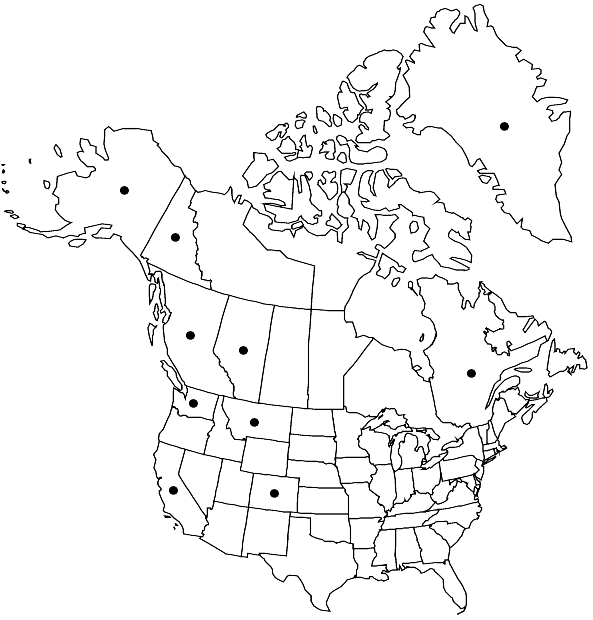Grimmia mollis
Bryol. Europ. 3: 133, plate 253. 1849,.
Plants in loose patches, green. Stems 1–5 cm, central strand present. Leaves oblong to ovate-lanceolate, 2–3 × 0.8–1 mm, margins plane, incurved distally, muticous, concave, apex rounded to cucullate, costa not projecting on abaxial side, subpercurrent; basal juxtacostal laminal cells quadrate, thin-walled; basal marginal laminal cells quadrate, thin-walled; medial laminal cells quadrate, thin-walled; juxtacostal and marginal distal laminal cells 1-stratose. Sexual condition dioicous. Seta straight, 2–3 mm, yellowish. Capsule sporadically present, exserted, yellowish, ovoid to oblong, smooth, exothecial cells thick-walled, annulus absent, operculum rostellate, peristome teeth purple, perforated, fully developed, papillose. Calyptra cucullate.
Habitat: Wet acidic rocks in alpine and boreal habitats
Elevation: moderate to high elevations (1000-4100 m)
Distribution

Greenland, Alta., B.C., Que., Yukon, Alaska, Calif., Colo., Mont., Wash., Eurasia.
Discussion
Grimmia mollis, discovered by Schimper in the Tirol of Austria, is a characteristic arctic-alpine species, frequently growing in glacial streams, sometimes over reaches of hundreds of meters. Although the species is widespread in the Northern Hemisphere, it is nowhere common. It occurs exclusively above the treeline. Because of its unique subpercurrent costa, uniform lamina of quadrate, thin-walled cells, and peculiar ecological niche, it cannot easily be confused with any other species. I. Hagen (1909) placed it in a monotypic genus, Hydrogrimmia. This concept was followed by M. F. V. Corley et al. (1981). However, there are no significant morphological characters to separate it from Grimmia, prompting H. C. Greven (2003) to follow, in agreement with H. A. Crum and L. E. Anderson (1981), Bruch and Schimper’s original concept. This dioicous species grows in separate male and female cushions, and capsules are produced very rarely.
Selected References
None.